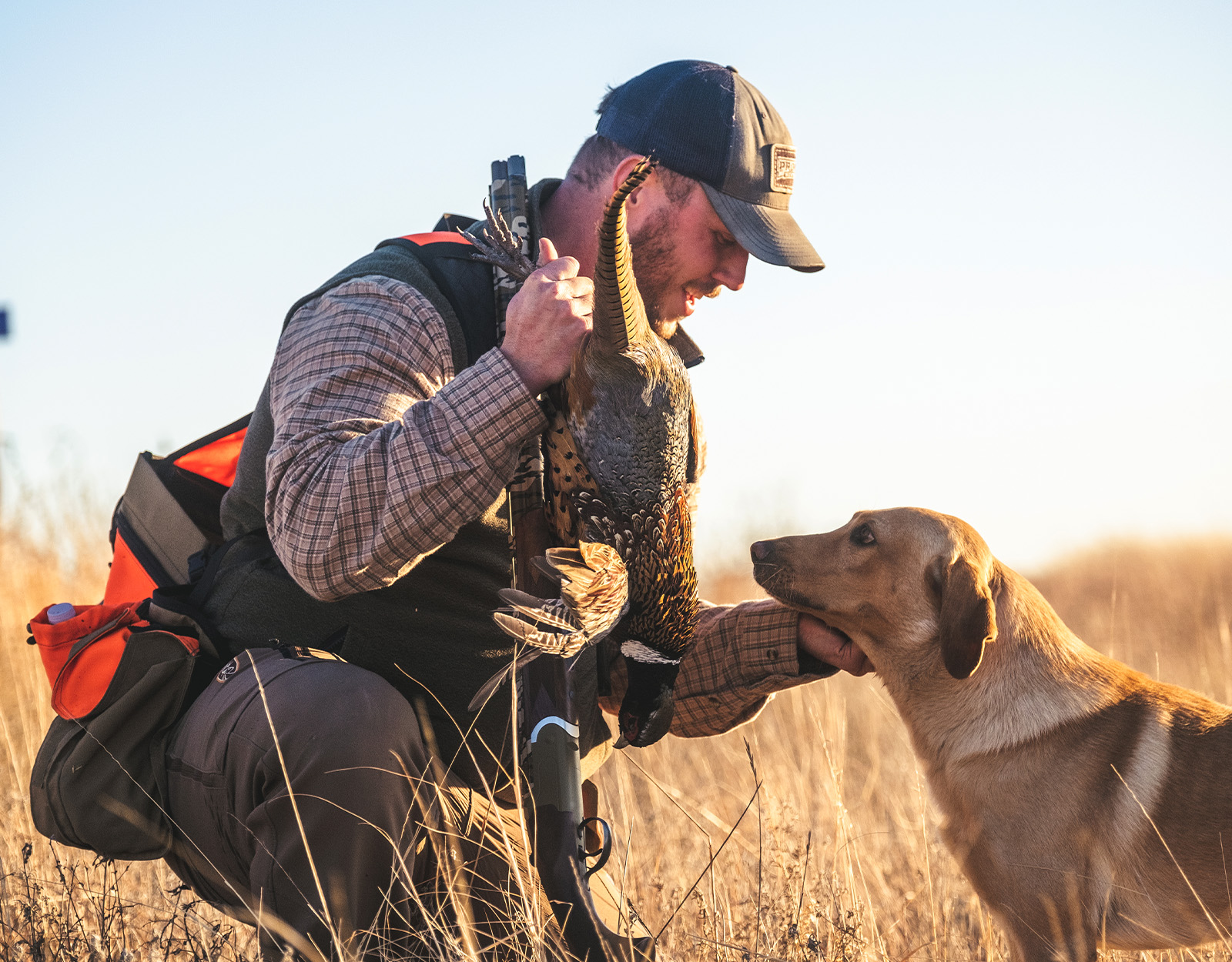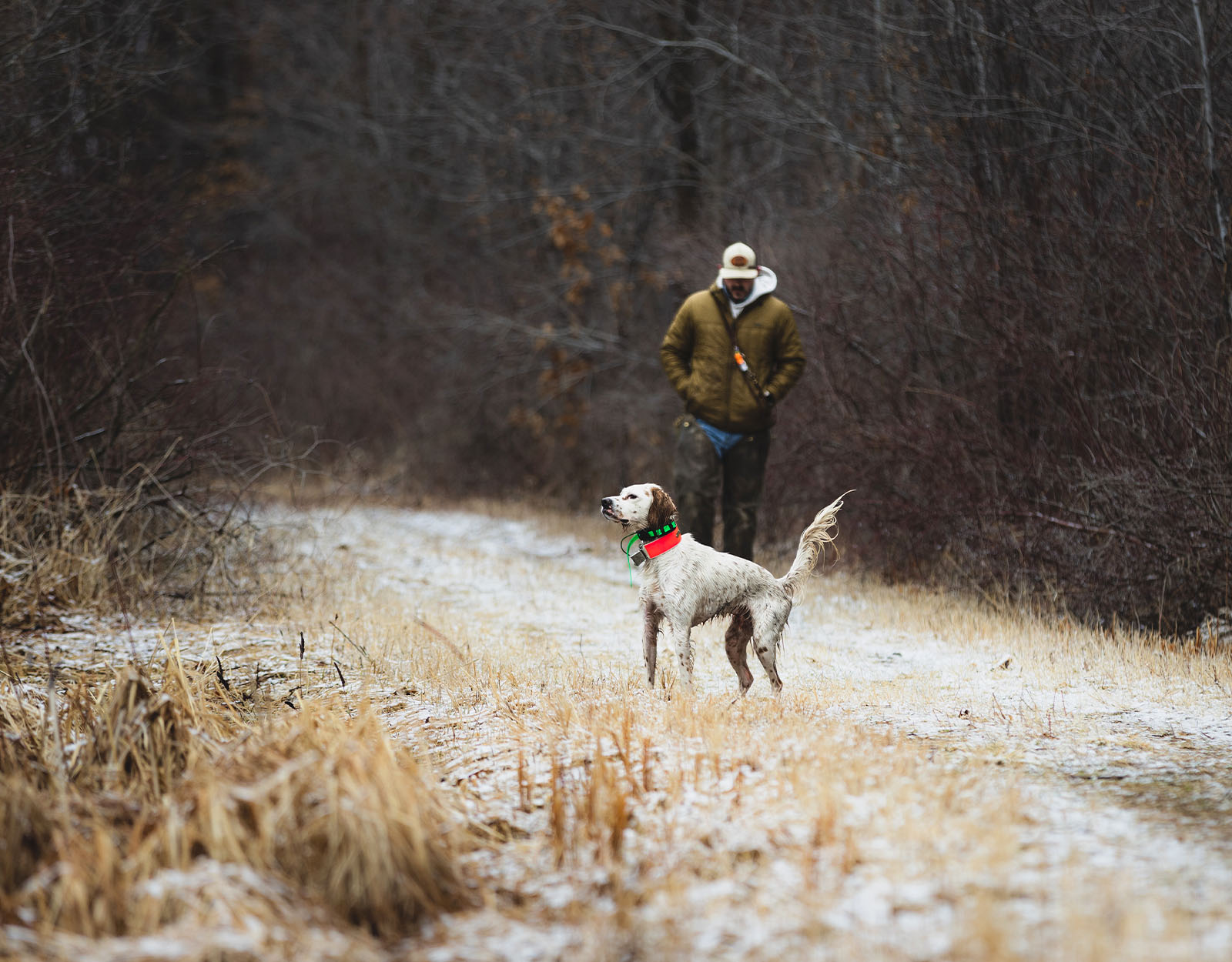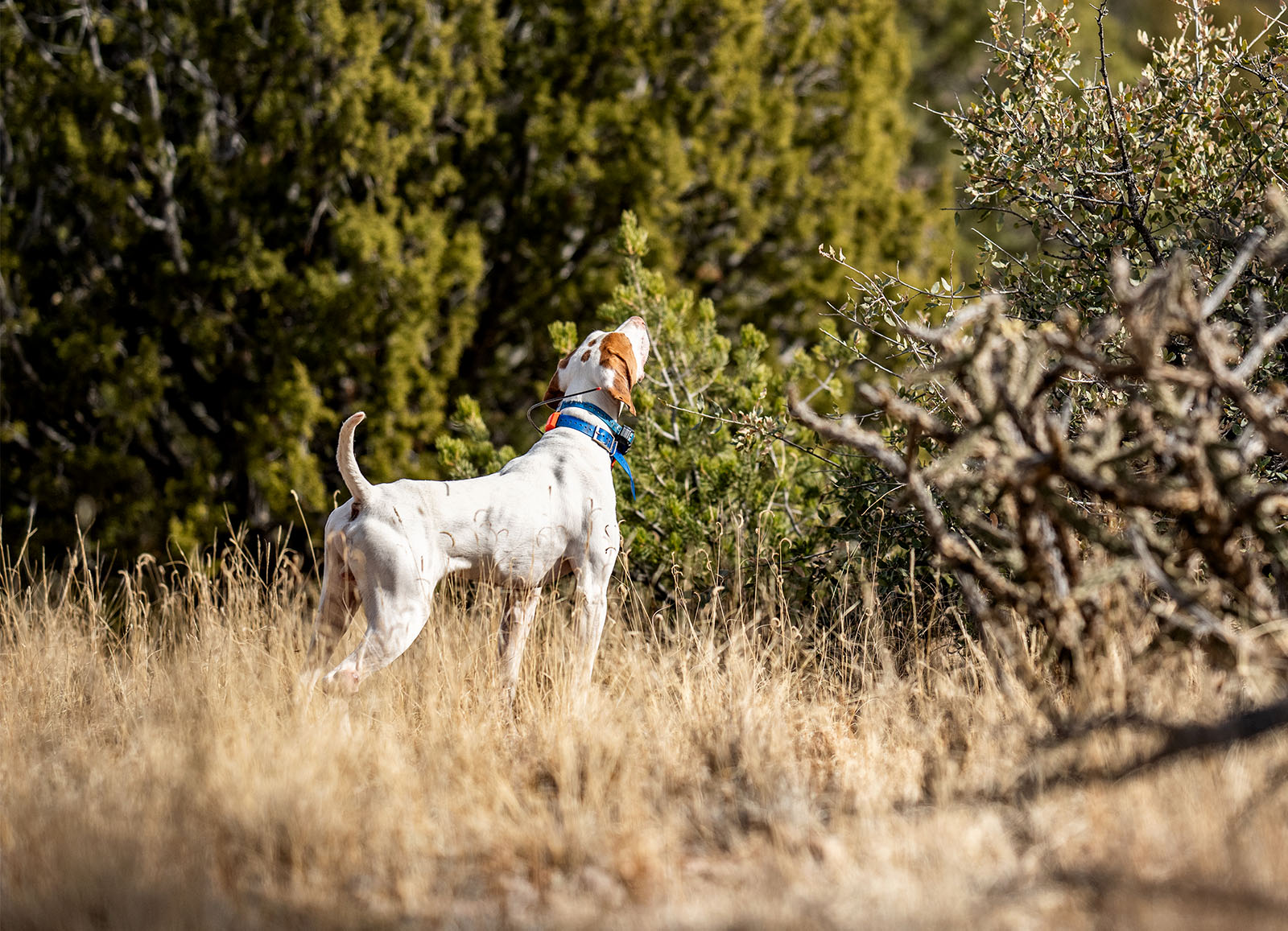An age-old debate: which hunting dog breed is best? Here, we offer our take on the best bird dog breeds by game bird. Whether you’re choosing your first bird dog or just here for a good debate, follow along as we cast our vote on hunting dog breeds worth upland bird hunters’ attention.
Ruffed Grouse Dogs
English Setter
The setter is not just a tool for the hunt but a living link to generations of upland tradition.
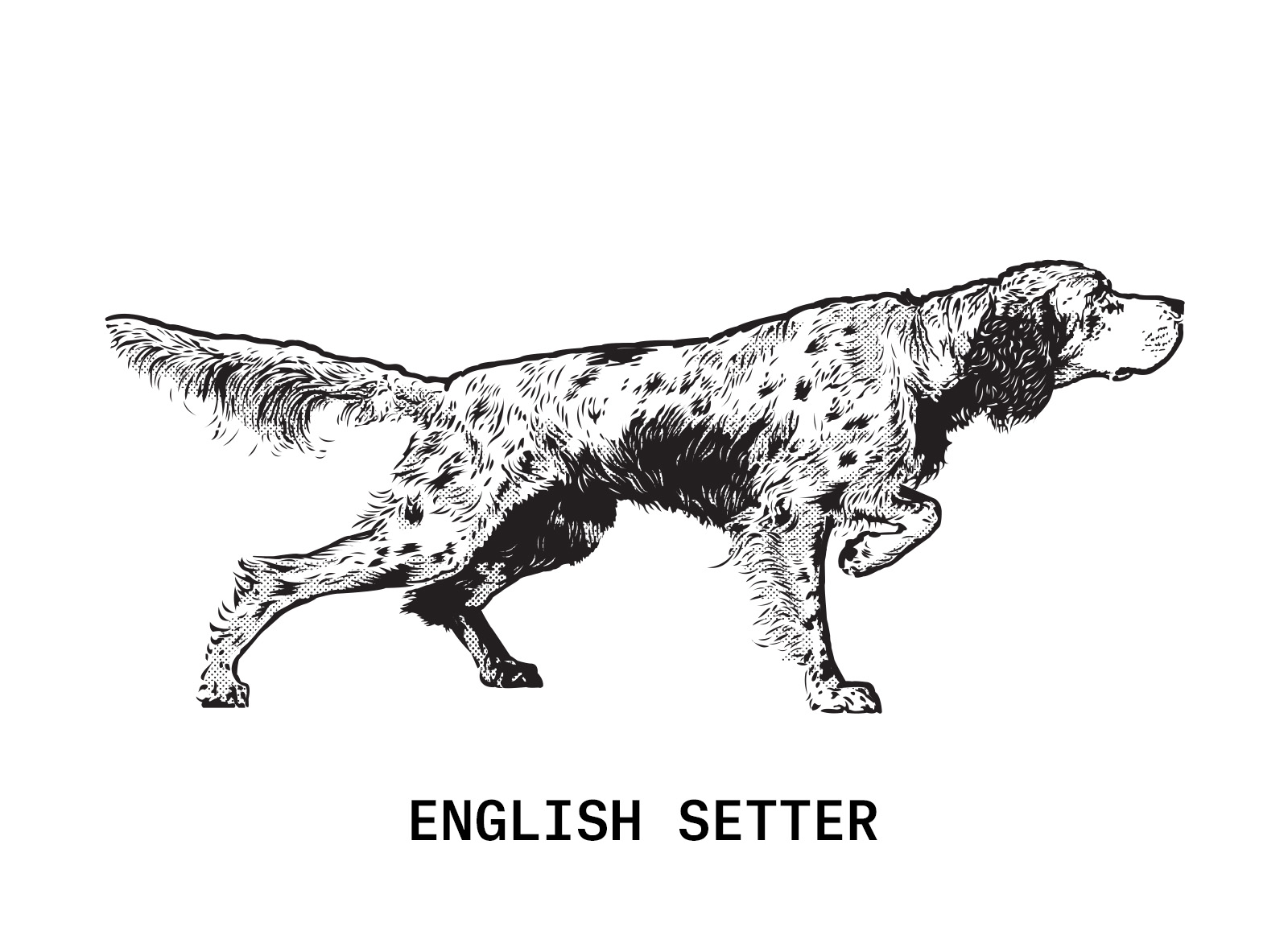
A setter is often regarded as the ultimate breed for hunting ruffed grouse due to its refined nose, graceful movement, and ability to work the tangled coverts where these elusive birds reside.
Grouse demand a dog that can navigate dense woods with finesse, casting methodically and adjusting to shifting scent cones without rushing the bird. Setters excel in this terrain, combining drive with a soft-footed approach that keeps pressure low and points honest, often locking up at just the right distance to give the hunter a shot. It’s no coincidence that setters represent the majority of dogs run in cover dog field trials, which are competitive events designed to replicate wild bird hunting in dense forest. The English setter’s dominance in these trials speaks to their unmatched instinct and adaptability.
Beyond their performance, there is something timeless about a setter working grouse cover. The image stirs a quiet nostalgia, with old bird covers, wool-clad hunters, and bells fading into silence just before a point. In that moment, the setter is not just a tool for the hunt but a living link to generations of upland tradition, moving through the woods with the same style and purpose as they did a century ago.
English Pointer
Pointers can display impressive bird sense, holding tight on even the wariest birds.
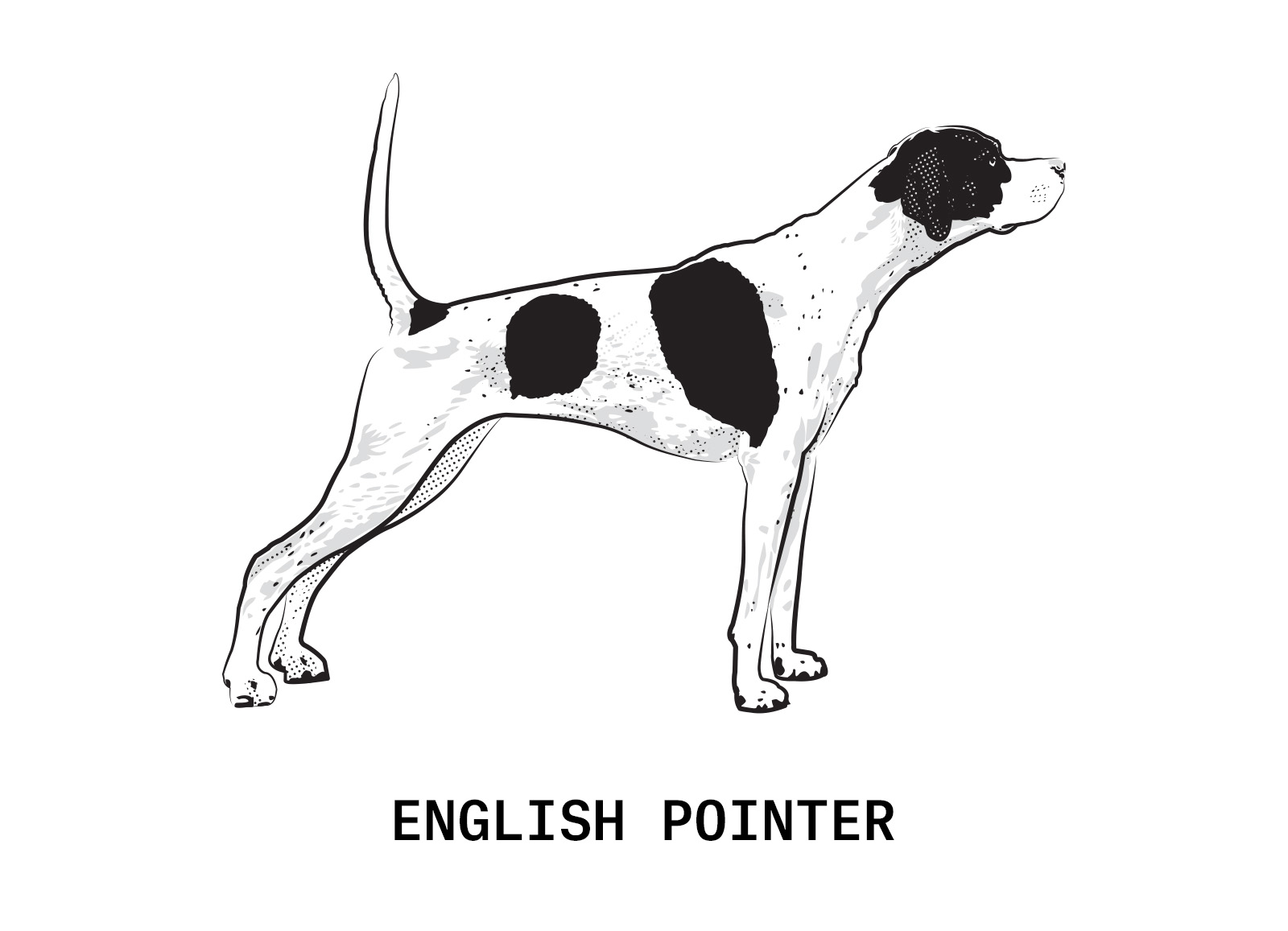
English pointers make outstanding grouse dogs thanks to their sharp noses, powerful ground game, and intense pointing style.
Though traditionally associated with open country, many pointers have adapted exceptionally well to the close, unpredictable cover that ruffed grouse favor. Their athleticism allows them to move efficiently through tangled woods, while their natural drive keeps them hunting hard all day.
When properly bred and trained for the grouse woods, pointers can display impressive bird sense, holding tight on even the wariest birds and giving the hunter a real chance at a flush. Part of the pointer’s reputation in the grouse woods comes from the influence of Bob Wehle and his Elhew line. While Elhew pointers were originally bred with field trials in mind, Wehle placed a strong emphasis on control, composure, and natural ability on wild birds — qualities that translate well to grouse hunting. Many grouse hunters favor Elhew-bred dogs for their combination of class and cooperation, making them a proven choice in the thick and demanding terrain of the Northwoods.
Brittany Spaniel
A Brittany becomes a steady, stylish, and highly effective partner.
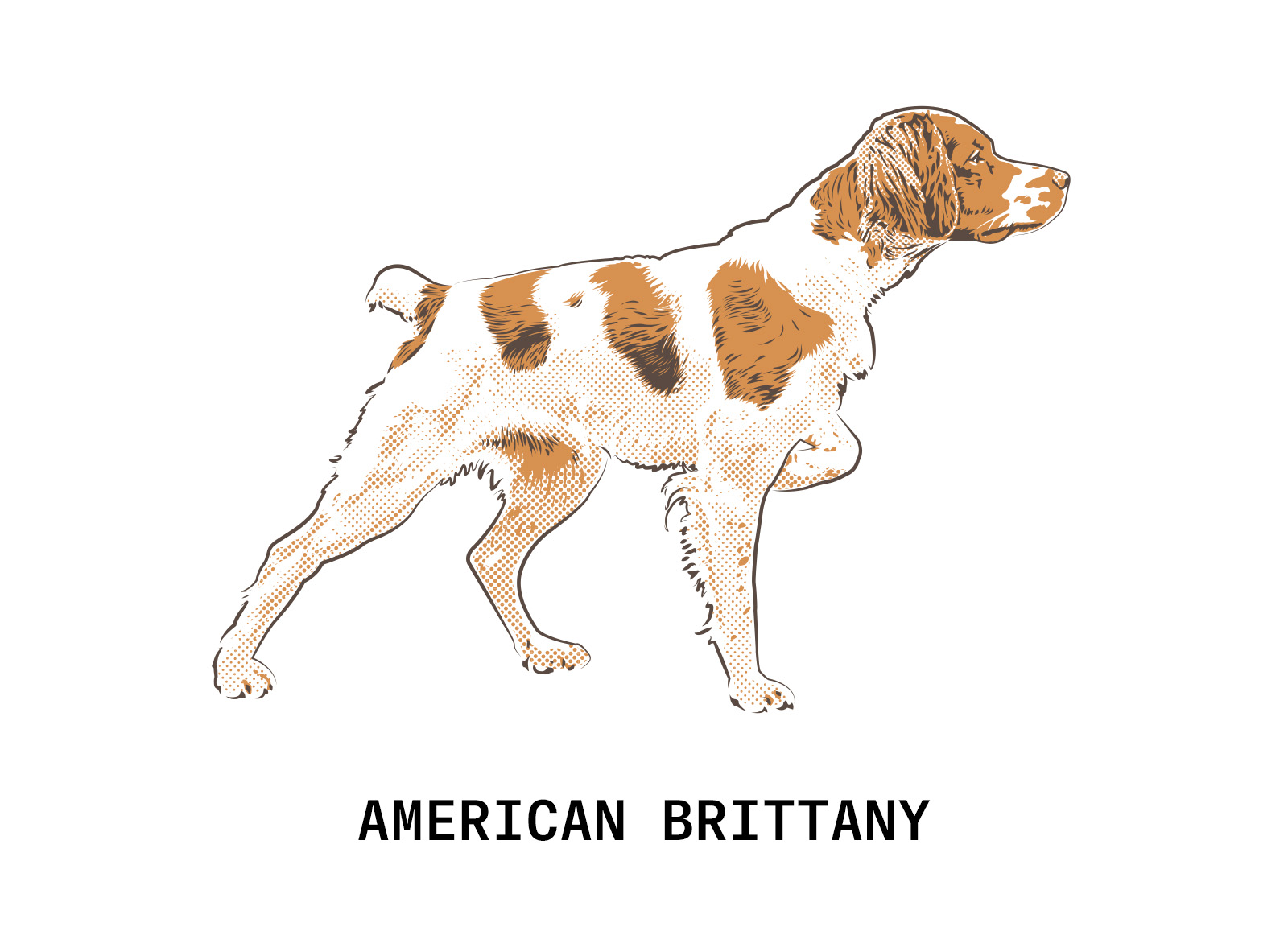
Brittany spaniels are well-suited for ruffed grouse hunting, combining a compact build, strong nose, and natural close-working range that fits perfectly into the tight, twisting cover where grouse thrive. Their smaller size allows them to slip effortlessly through dense alder thickets and young aspen stands, staying in touch with the gun without constant handling.
Known for their high energy and keen desire to find birds, Brittanys tend to develop quickly and show a strong natural point, making them an excellent choice for both new and seasoned upland hunters. Their versatility is one of their greatest strengths. Originally bred as all-purpose bird dogs in France, Brittanys are just as comfortable in grouse cover as they are on open prairie. In the grouse woods, they show patience and caution, learning to adjust their approach to the unpredictable nature of wild birds.
Many grouse hunters appreciate the Brittany’s combination of drive and sensitivity, along with their eagerness to please and close-working habits. With the right exposure and wild bird experience, a Brittany becomes a steady, stylish, and highly effective partner in the Northwoods.
Pheasant Hunting Dogs
Labrador Retriever
A well-trained Lab delivers consistent performance and unshakable enthusiasm.
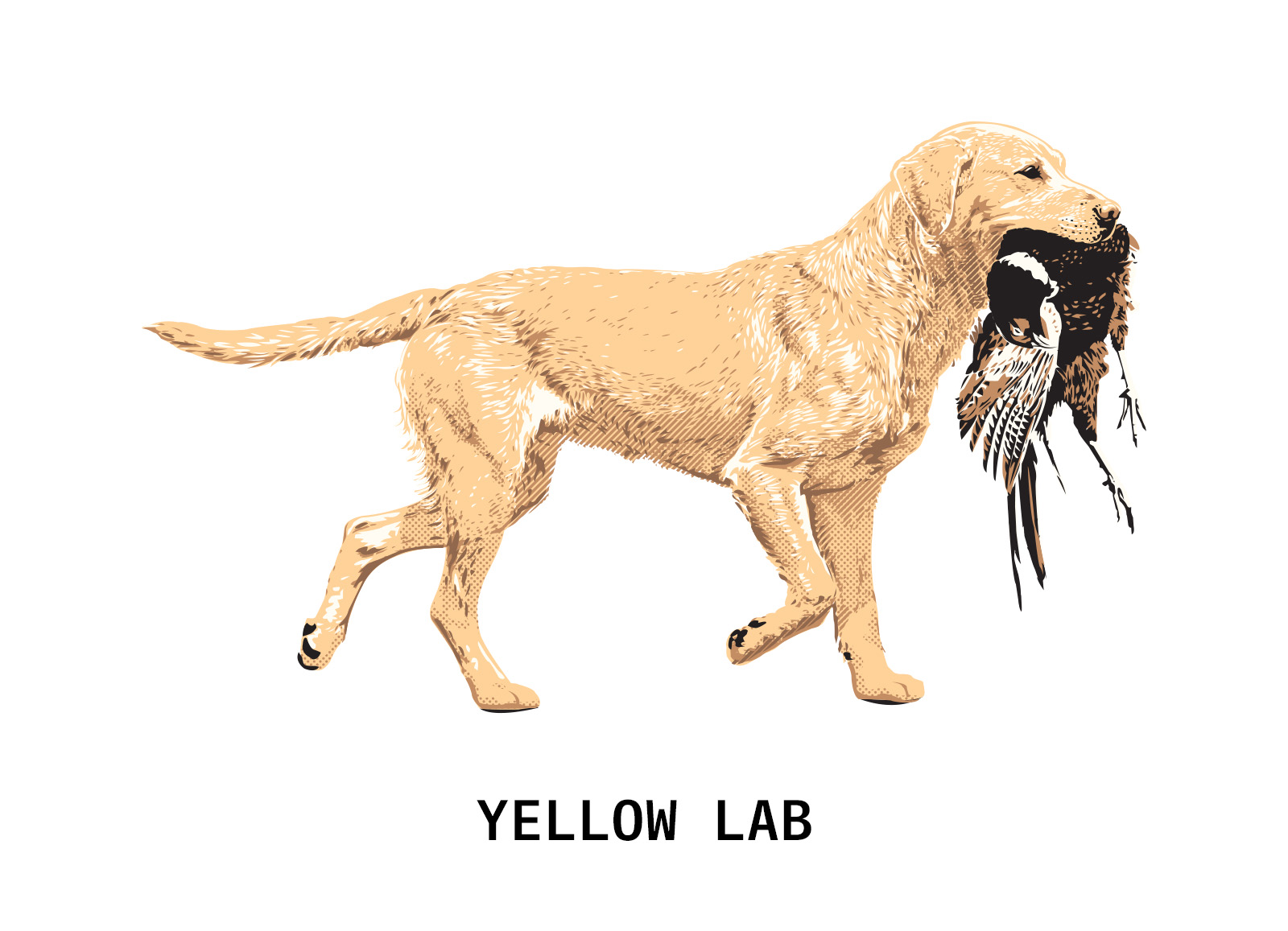
Labrador retrievers are exceptional pheasant dogs, combining drive, intelligence, and an incredible nose that makes them perfectly suited for the demands of pheasant country.
With a strong build and tireless work ethic, Labs thrive in the thick cover and varied terrain where pheasants hide. Whether it is cattails, brushy fence lines, or standing corn, they charge in with purpose and determination. Their ability to track running birds and flush them cleanly is a key asset, especially when roosters try to escape on foot. Once the bird is down, a Lab’s natural retrieving instinct and soft mouth ensure it is quickly and cleanly recovered.
Labs also bring a steady, biddable temperament to the field, making them easy to train and dependable in all types of hunting situations. They tend to work at a practical range, staying in tune with the gun while confidently pushing through tough cover. Their eagerness to please and adaptability in both field and water add to their reputation as the ultimate pheasant hunting companion.
From early morning pushes to late season retrieves in frozen marshes, a well-trained Lab delivers consistent performance and unshakable enthusiasm every step of the way.
German Shorthaired Pointer
A GSP’s athletic build and tireless energy make it ideal for covering ground.
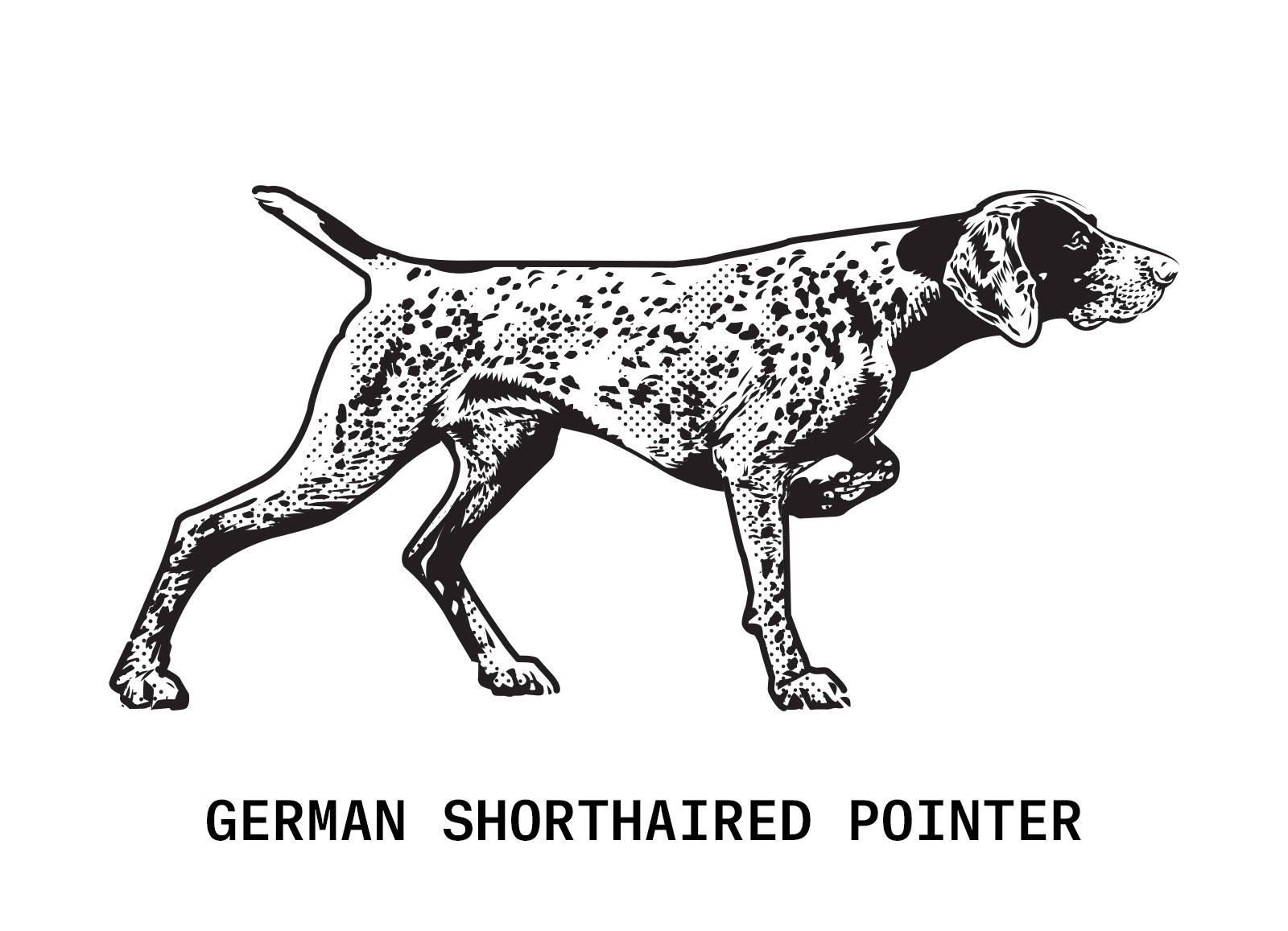
Hunting pheasants presents a unique set of challenges: birds that run before they flush, thick cover that conceals them well, and unpredictable flight patterns once they’re airborne. This is where the German shorthaired pointer (GSP) truly shines.
GSPs have an exceptional nose and a natural instinct to track running birds, a trait especially valuable with pheasants, which are notorious for staying ahead of slower, less driven dogs. A well-trained GSP will work a zigzag pattern through tall CRP grasses or cattail sloughs, methodically cutting scent and adjusting pace as it closes in, resulting in a pinned bird with a solid, stylish point that allows you to move in before the flush.
Beyond their scenting and pointing ability, GSPs are built for stamina and agility. Pheasant country often demands long hours of walking through uneven, brushy terrain, and a GSP’s athletic build and tireless energy make it ideal for covering that ground effectively. They’re also excellent at retrieving, crucial when a bird drops in thick cover or runs after being hit. Many GSPs naturally retrieve, and are just as comfortable busting through cattails as they are navigating stubble fields.
Their combination of intelligence, prey drive, and adaptability makes them one of the most effective dogs for the dynamic, often unpredictable nature of pheasant hunting.
Springer Spaniel
They hunt with heart but also with an impressive level of focus.
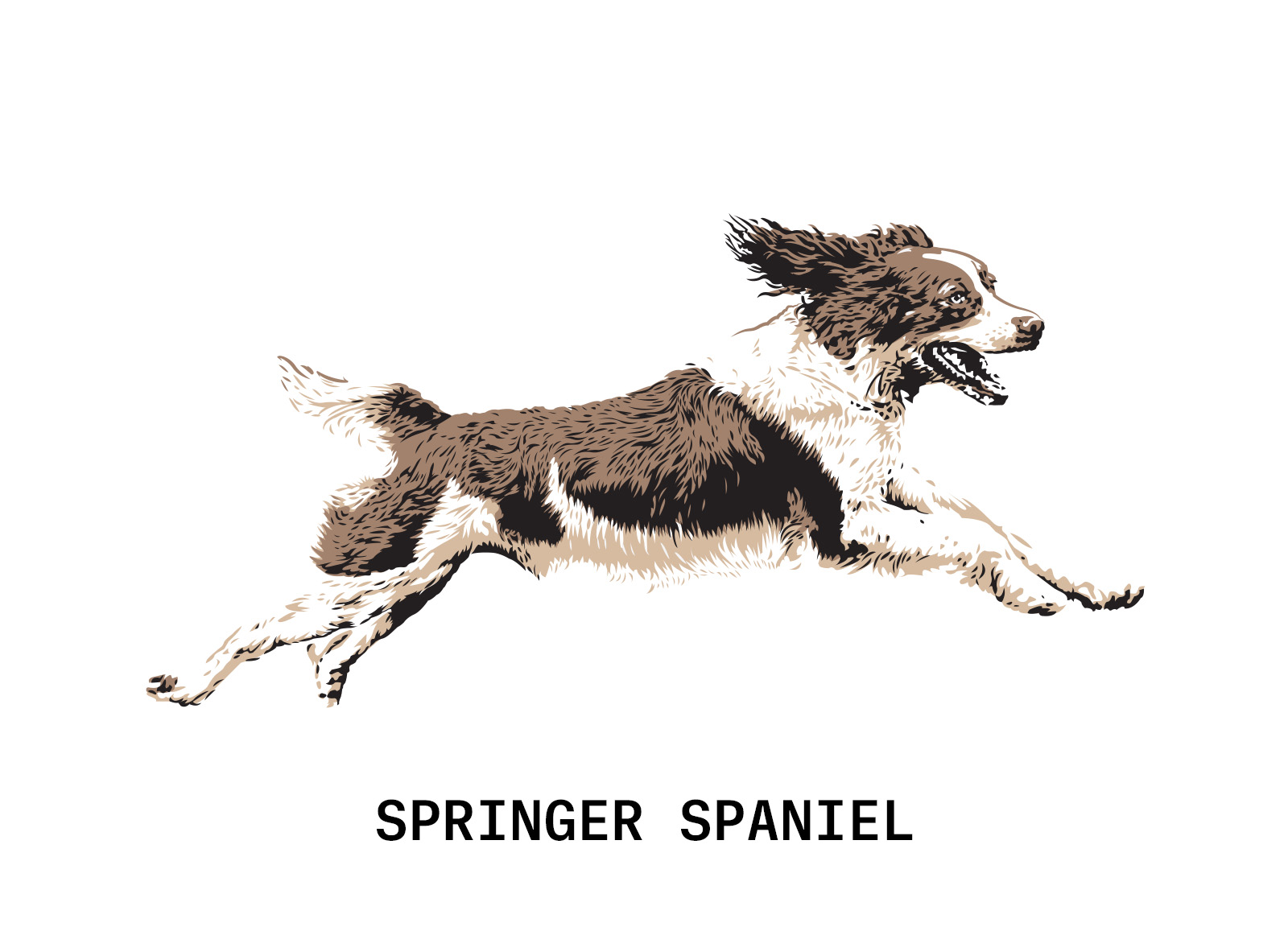
Springer spaniels are born pheasant hunters, known for their relentless drive, excellent noses, and explosive flushes. Their compact size and boundless energy make them perfectly suited for diving into thick cover, pushing through tangled grass, brush, and cattails with ease.
Springers work in close partnership with the gun, quartering naturally in front and using their keen sense of smell to root out hidden birds. When a rooster erupts from the cover, it’s often because a springer forced the issue with controlled pressure and sharp instincts.
What sets springers apart is their combination of enthusiasm and precision. They hunt with heart but also with an impressive level of focus and discipline when properly trained. Their natural connection with handlers, combined with a strong retrieving instinct, makes them as effective in the water as they are in the field.
Whether hunting early-season birds in milo fields or pushing frozen creek bottoms late in the year, a springer spaniel brings unmatched excitement and efficiency to every flush and retrieve.
Quail Hunting Dogs
English Pointer
Always forward, always focused, and always hunting with breathtaking purpose.

Pointers are widely regarded as the premier breed for quail hunting, known for their intensity, speed, and unmatched bird-finding ability. Their powerful, fluid movement allows them to cover ground efficiently, casting wide across open fields and piney woods where quail are often found.
With a sharp nose and an instinctive feel for the wind, a good pointer can locate coveys from remarkable distances and hold them with a level of style and confidence that has come to define the breed. One of the key reasons pointers thrive in quail country is their natural tolerance for heat, which allows them to hunt hard even in the warm climates of the Southeast and Southwest. Their lean build and efficient gait help them stay cool and conserve energy over long days in the field.
Whether on a sprawling Southern plantation or in the mesquite flats of Texas, a pointer moves like it was born for the job, always forward, always focused, and always hunting with breathtaking purpose.
Cocker Spaniel
Their compact size allows them to slip through dense brush and briars where quail often hold tight.
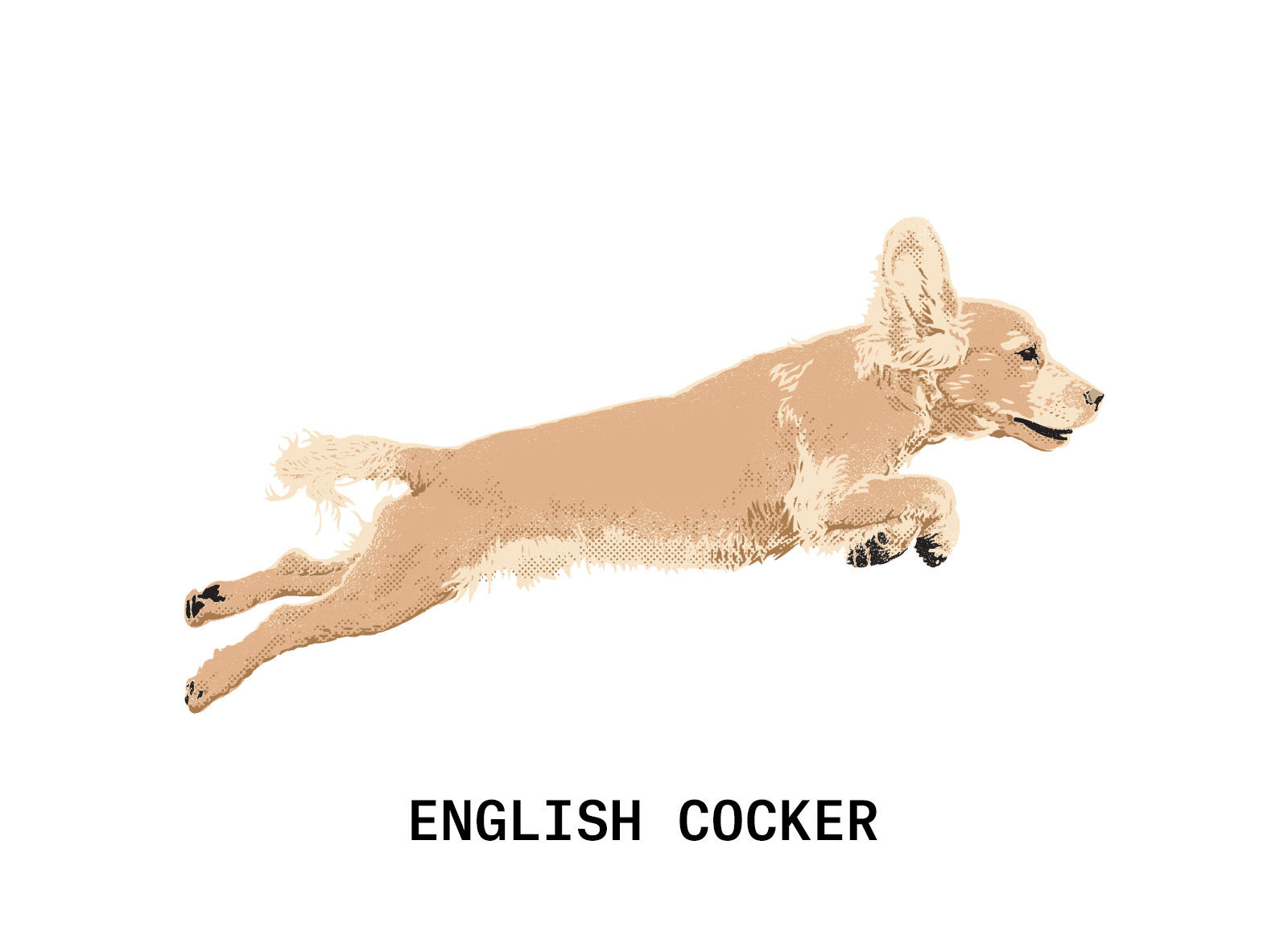
Cocker spaniels are an ideal complement to a pointing dog in quail hunting, bringing explosive energy, tight handling, and a natural flush that adds rhythm to the hunt. When used behind a pointer, a well-trained cocker works in close with intensity and control, charging into cover to put coveys in the air with a thrilling burst of action. Their compact size allows them to slip through dense brush and briars where quail often hold tight, ensuring birds are flushed cleanly and within gun range.
What makes cockers especially valuable is their enthusiasm and efficiency. They stay close, respond well to cues, and bring a lively pace to the hunt without overwhelming the work of the pointer. Their strong retrieving instinct and eagerness to please mean downed birds are quickly and reliably recovered.
In a well-coordinated team, the pointer finds and holds, the cocker flushes, and the result is a dynamic, fast-paced experience perfectly suited to the elusive nature of quail.
German Shorthaired Pointer
A dog that not only finds birds but ensures few are lost.

Quail hunting demands precision, patience, and finesse, qualities that align perfectly with the natural abilities of the GSP. Unlike pheasants, quail hold tight in coveys, often in sparse grass, brush edges, or under low cover. GSPs have an uncanny ability to delicately work close-range scent, using their sharp nose and intelligent pacing to avoid bumping birds prematurely. Their instinctive point is steady and stylish, giving you ample time to position yourself before the explosive flush of a covey, a moment where timing is everything.
Another advantage of the GSP in quail country is its agility and responsiveness in tight, brushy terrain. Quail often flush low and erratically, requiring a dog that can stay composed and steady through the chaos. GSPs are highly trainable and typically handle well off-leash, allowing for quiet, controlled movements through cover without spooking birds. Their biddable nature means they take direction readily, can hold point for extended periods, and will honor another dog’s point, which is invaluable when hunting in a brace. Add in their natural retrieving instincts, and you’ve got a dog that not only finds birds but ensures few are lost, which is essential when shooting smaller game like quail that can vanish quickly into cover.
Lastly, as their name suggests, GSPs have a short coat, making them resilient in the higher temps that tend to be synonymous with quail country. In short, the GSP’s balance of drive, discipline, and grace makes it one of the best breeds for navigating the subtleties of quail hunting.
Prairie Grouse Dogs
English Pointer
Their ability to locate and hold birds with confidence and style makes them a natural fit for the prairie.

The English pointer is ideally suited for hunting prairie grouse, including prairie chicken and sharp-tailed grouse, thanks to its wide-ranging ability, endurance, and refined bird-sense.
Prairie grouse inhabit expansive grasslands where a dog must cover large areas methodically and stay attentive to subtle shifts in wind and terrain. Pointers are built for this kind of work, moving with effortless speed and purpose while maintaining strong ground connection and responsiveness to the handler. Their ability to locate and hold birds with confidence and style makes them a natural fit for the prairie.
With excellent heat tolerance and a deep-rooted drive to hunt, English pointers bring efficiency and grace to the vast, open country that prairie grouse call home.
English Setter
Their classic, high-tailed points give hunters time to walk in and prepare for the flush.

English setters are a natural fit for hunting prairie grouse, combining athleticism, range, and a soft, intelligent approach that matches the rhythm of the open grasslands.
Prairie grouse often hold well for a careful dog, and setters excel at working scent with finesse, adjusting their pace to the birds and terrain. Their flowing movement and natural ability to use the wind make them highly effective in covering ground without overreaching, while their classic, high-tailed points give hunters time to walk in and prepare for the flush. Setters also bring a level of grace and cooperation that makes them a pleasure to watch and handle on the prairie. Their stamina and adaptability allow them to perform well across varied conditions, from early-season heat to crisp fall mornings.
With a calm, confident demeanor around birds and a deep-rooted desire to hunt as a team, English setters offer a refined yet capable presence in the sweeping landscapes where prairie grouse thrive.
German Shorthaired Pointer
A big motor, a sharp nose, and the discipline to hold a point on birds that often flush wild and wary.

Prairie grouse, like sharptails, sage grouse, and prairie chickens, demand a dog with a big motor, a sharp nose, and the discipline to hold a point on birds that often flush wild and wary. The GSP is built for this kind of open-country hunting.
With a strong, ground-covering stride and the endurance to hunt from sunup to sundown, a GSP can range wide across vast prairies without wearing down. Their natural quartering ability and responsiveness to whistle or GPS collar commands make them ideal for the kind of big-loop, long-range work often required to locate scattered or loosely grouped birds like sharptails and prairie chickens.
What sets the GSP apart in this environment is not just its range, but its ability to adapt to bird behavior. Prairie grouse are known for their skittishness, often flushing at the first sign of pressure. GSPs, with their exceptional scenting ability and experience-driven pacing, learn to slow down as scent gets hot, pinning birds with a steady point that gives hunters a rare chance to close distance before the flush.
Their short coat is another advantage on the prairie: it keeps them cool during early season heat but is dense enough to guard against abrasive grasses and burrs. Whether working vast sage flats for sage grouse or navigating broken prairie for chickens and sharptails, the GSP’s stamina, intelligence, and precision make it a top-tier companion for hunting prairie grouse.
Chukar Hunting Dogs
German Wirehaired Pointer
When the terrain gets brutal and the birds get cagey, a GWP stays in the game.
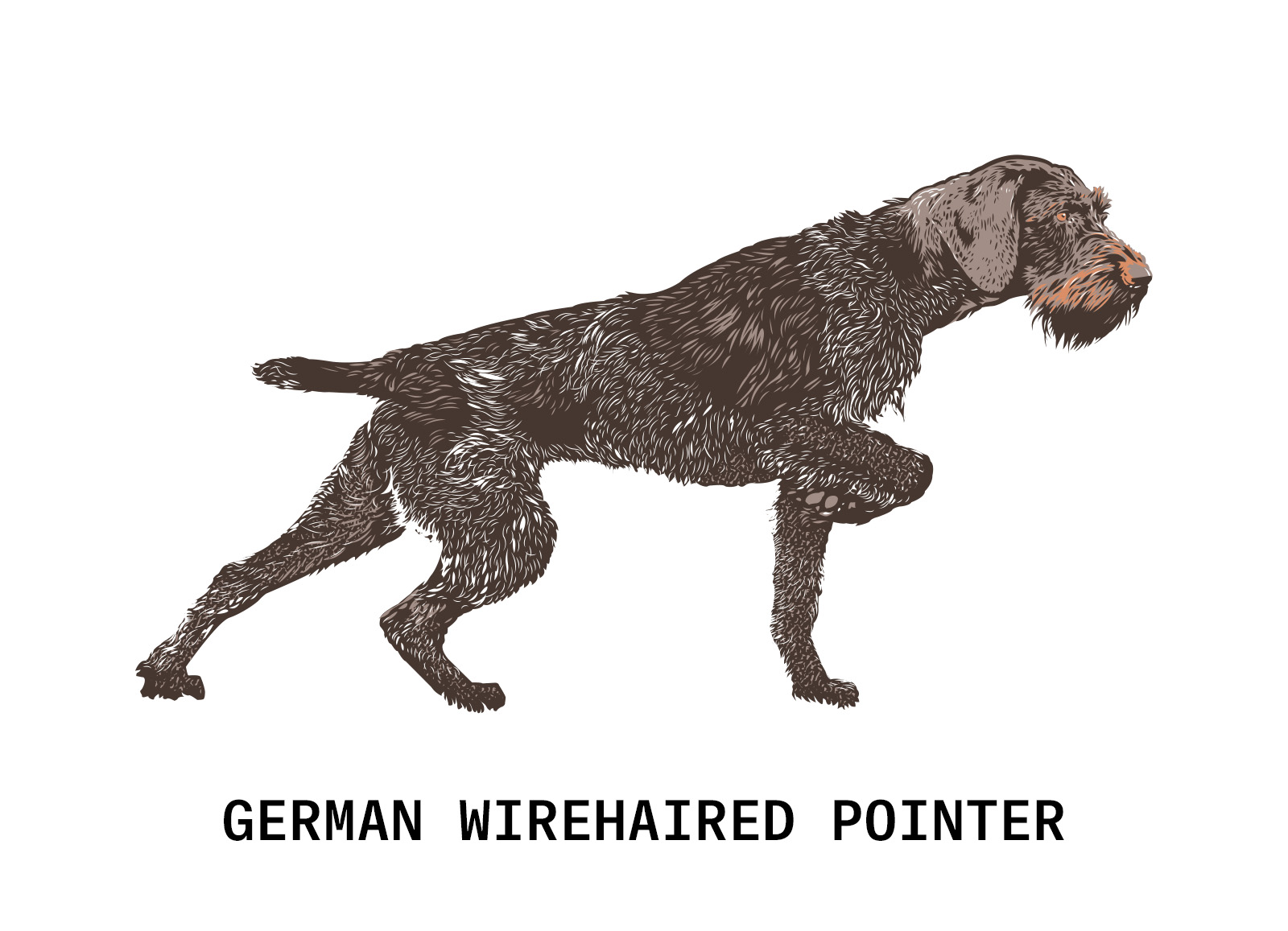
Hunting chukar is one of the most physically demanding upland pursuits, requiring a dog with toughness and grit, and the German wirehaired pointer (GWP) is built for exactly that.
Chukar live in some of the roughest country in North America: steep, rocky slopes, high-desert plateaus, and loose shale ridges that test the stamina of both hunter and dog. GWPs are rugged, athletic, and durable, with a strong, muscular build that thrives in this kind of terrain. Their wiry, weather-resistant coat provides critical protection against sharp rocks, cactus, and dry brush, while still being breathable enough to keep them cool during long climbs and warm in unpredictable mountain weather.
But chukar hunting isn’t just about physical endurance, it’s about strategy and bird-savvy. Chukar are notorious for running uphill ahead of dogs and flushing wild if pressured too hard. A GWP’s deliberate, intelligent style of ground work allows it to track running birds without bumping them prematurely. Their excellent noses and steady pointing instinct give hunters a chance to close the distance before the covey breaks.
GWPs are also known for their mental toughness and resilience: They don’t back down from harsh conditions, long days, or stubborn birds. When the terrain gets brutal and the birds get cagey, a GWP stays in the game, making them one of the most reliable and capable partners for hunting chukar in the toughest upland country.
German Shorthaired Pointer
A well-conditioned GSP is more than a bird dog, it’s an essential partner.

Chukar hunting is often called the “game of vertical miles,” and few dogs are as well-equipped for it as the GSP. These birds thrive in steep, rocky, high-desert terrain where both hunter and dog are constantly climbing, side-hilling, and navigating loose shale and scrub. A GSP’s lean, muscular frame and high stamina are perfectly suited for these demands, allowing them to handle the physical punishment of chukar country without slowing down. Their efficient gait and strong cardiovascular conditioning help them hunt all day in terrain that wears out less athletic breeds in a matter of hours.
What makes a GSP particularly effective for chukar is not just their endurance, but their ability to adjust to the bird’s frustrating behavior. Chukar often run uphill ahead of pressure, only to flush wild or drop into a ravine behind you. GSPs combine drive with intelligence, learning to work birds with caution, anticipate movement, and establish a solid point before the covey breaks.
Their short, heat-tolerant coat helps them stay cool in the warm, arid environments where chukar live, while their grit and mental toughness mean they’ll keep pushing even when the climbs get steep and the birds get smart. For hunters who chase chukar across the rimrock, a well-conditioned GSP is more than just a bird dog, it’s an essential partner.
English Setter
Their natural range and bird sense allow them to locate coveys that often hold high on slopes or tuck into brushy draws.

English setters are well-suited for chukar hunting thanks to their stamina, light-footed movement, and ability to handle challenging terrain with grace and grit. Chukar country is steep, rocky, and demanding, often requiring a dog that can cover ground efficiently without burning out. Setters excel in these conditions, using their athletic build and smooth gait to climb ridges, sidehill across scree, and work the wind with precision.
Their natural range and bird sense allow them to locate coveys that often hold high on slopes or tuck into brushy draws, and their controlled approach helps prevent early flushes in pressure-sensitive birds. With a strong desire to hunt and a cooperative mindset, setters bring both effectiveness and elegance to the rugged world of chukar hunting.
Best Versatile Breeds
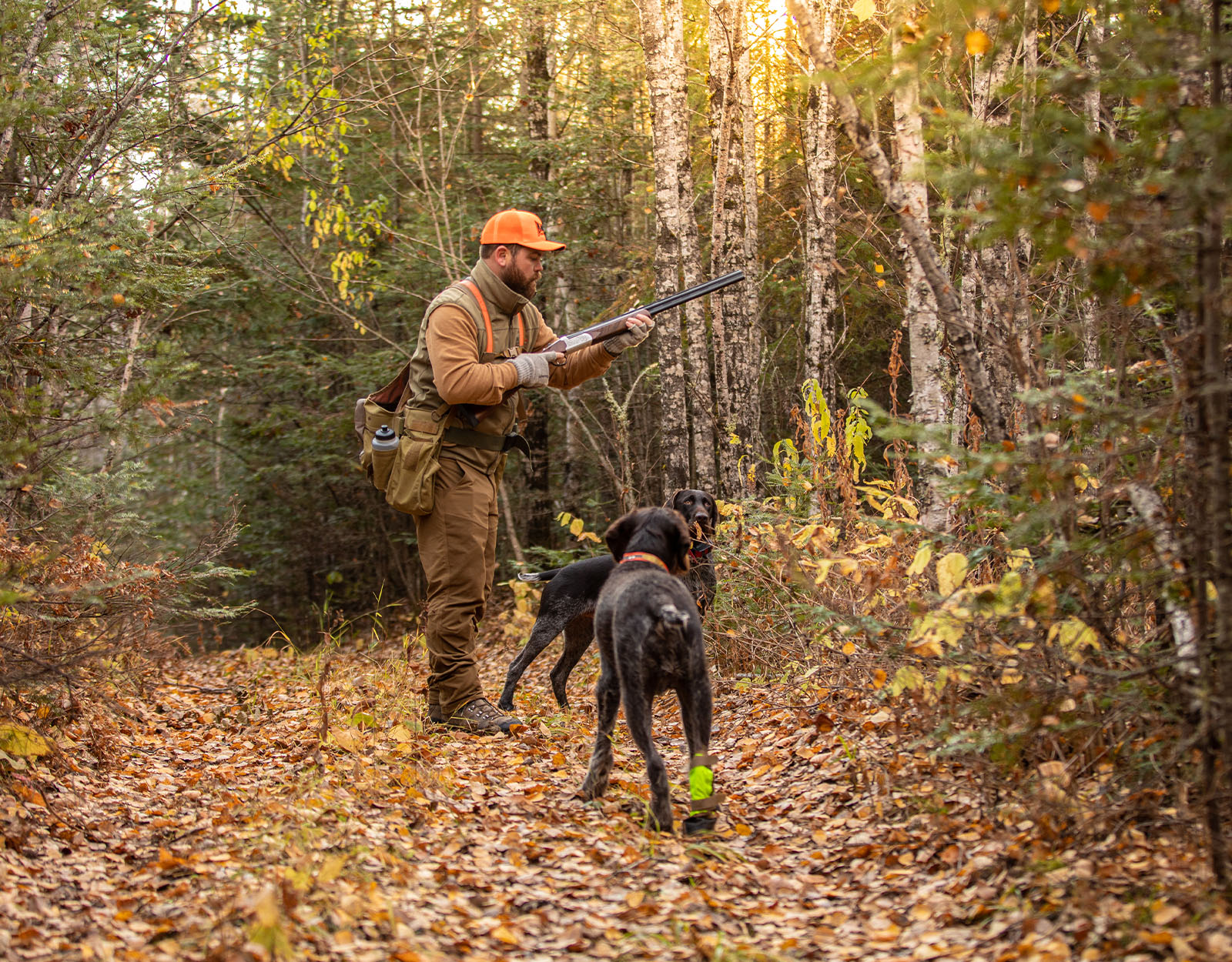
German Shorthaired Pointer
The GSP has the drive, nose, and adaptability to handle it all.

The GSP is the epitome of a versatile upland bird dog, making it an exceptional choice for hunters who pursue a variety of game birds throughout the season. Whether you’re busting through cattails for late-season roosters, ranging across prairie for sharptails, weaving through brush for quail, running timber for ruffed grouse, or scrambling up steep ridges for chukar, the GSP has the drive, nose, and adaptability to handle it all.
Their athleticism and stamina allow them to cover ground in big country when needed, but they also possess the control and precision to work tight quarters for close-holding birds. That balance of range and responsiveness is what makes them so effective across vastly different terrains and bird behaviors.
A GSP’s versatility goes beyond physical capability — their mental flexibility is just as valuable. They learn quickly and adjust their approach to match the birds and environment. They’ll slow down and work carefully for spooky quail or ruffed grouse, then open up and range wide for scattered prairie grouse. Their strong natural point, solid retrieve, and biddable nature make them easy to train across species and situations. Add to that their short, dense, heat-tolerant coat that handles everything from warm southern quail fields to frosty Midwestern corn stubble, and you have a dog that can go wherever upland birds take you.
For hunters who want one dog that can do it all, and do it well, the GSP is tough to beat.
Labrador Retriever
One of the Lab’s greatest strengths is its adaptability to different hunting scenarios.

The Lab stands out as one of the best all-around upland hunting dogs due to its versatility, trainability, and steady drive in the field. Labs thrive in a variety of upland settings, from the thick, tangled cover of grouse and woodcock country to the wide, open fields where pheasants and quail roam. Their natural instinct to flush birds cleanly and retrieve them with a soft mouth makes them a reliable partner across many types of hunts. Labs tend to work at a close, manageable range, allowing the hunter to stay connected to the dog while navigating heavy cover or tight quarters.
One of the Lab’s greatest strengths is its adaptability to different hunting scenarios. They are just as comfortable working solo with a single hunter as they are operating within large groups during organized pushes. In either setting, their even temperament, focus, and biddability help them stay composed and effective. Whether navigating a quiet morning in the woods or powering through rows of milo alongside other hunters and dogs, a well-trained Lab brings consistency and control to the hunt.
For upland hunters looking for a dependable, all-around performer, Labs continue to be a top choice.
German Wirehaired Pointer
Few breeds offer the same combination of toughness, versatility, and instinct.

The GWP is one of the most versatile and rugged breeds in the upland world, making it an outstanding choice for hunters who pursue a variety of game birds across diverse terrains and climates. Whether you’re chasing sharp-tailed grouse on wide-open prairies, quail in tangled southern thickets, or pheasants in icy CRP fields, the GWP adapts with ease.
Bred for versatility, GWPs have the endurance for big-ranging hunts, the control and patience for tight cover work, and a natural ability to track, point, and retrieve, all wrapped into one durable package. Their coarse, weather-resistant coat offers excellent protection against heat and cold, as well as thorns, briars, and harsh terrain, allowing them to hunt effectively from the sweltering South to snow-covered northern plains.
What sets the GWP apart is not just its physical toughness but its mental adaptability. These dogs are intelligent, eager to work, and quick to adjust their hunting style based on the bird and conditions at hand. They’ll run hard and cover ground when birds are spread out, or tighten up and work methodically when game is holding close. Their strong prey drive is matched by a cooperative nature, making them easy to train across multiple bird species and responsive in the field.
With a GWP by your side, you get a dog capable of transitioning seamlessly between different upland hunts — quail, chukar, pheasant, grouse, woodcock, or anything in between — without sacrificing performance. For the all-around upland hunter, few breeds offer the same combination of toughness, versatility, and instinct.
Honorable Mentions
Vizsla
A spirited, adaptable dog that excels across a broad spectrum of bird species.
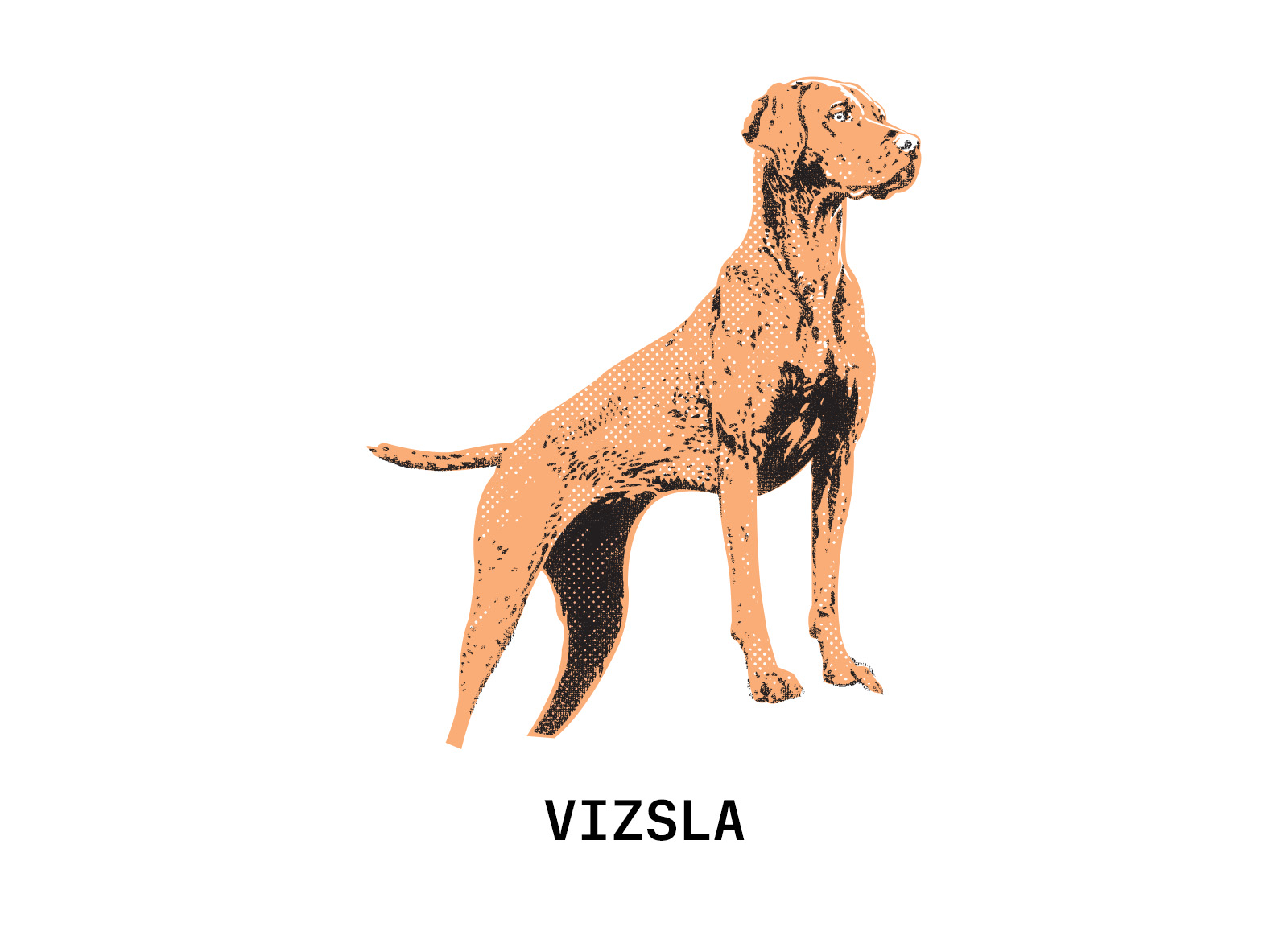
While often overshadowed by more traditional pointing breeds, the vizsla deserves honorable mention as a highly versatile upland hunting dog. Known for their sleek, rust-colored coat and elegant build, vizslas combine a natural hunting instinct with remarkable speed and endurance. They are excellent at covering ground quickly, making them well-suited for hunting a wide variety of upland birds, from fast-flushing quail and partridge to more open-country birds like pheasants and grouse. Their sensitivity to handler cues and affectionate nature also make them a joy to work with in the field.
Though not as ruggedly built as some of the wirehaired or more heavily coated breeds, the vizsla’s short coat is ideal for warmer climates and late-season upland hunts where thick brush and heat can be a factor. They adapt well to different terrains and hunting styles, showing both the drive to range wide and the patience to work close when needed.
While they may require more attention to coat care and protection in harsher environments, their intelligence, versatility, and enthusiastic attitude make them a worthy companion for upland hunters who want a spirited, adaptable dog that excels across a broad spectrum of bird species.
Pudelpointer
Their natural retrieving instincts and love of water add another layer of versatility.
The pudelpointer, a unique blend of the German pointer and hunting poodle, earns its place as an honorable mention among versatile upland hunting dogs. This breed combines the sharp pointing instinct and drive of the pointer with the intelligence and water-loving traits of the poodle, creating a dog that excels in a wide range of hunting scenarios.
Whether navigating thick brush for quail, working open fields for pheasants, or covering rugged terrain for grouse, the pudelpointer’s keen nose and steady point make it an effective and reliable partner. Their natural retrieving instincts and love of water add another layer of versatility, especially useful in wetter upland environments where other pointers might struggle.
One of the Pudelpointer’s standout qualities is its adaptability, not just physically but mentally. They are highly trainable and eager to please, quickly learning to adjust their style and intensity based on the type of bird and terrain. Their dense, curly coat offers protection against thorns and cold weather, making them well-suited for varied climates and conditions.
While not as widely known as some other breeds, the pudelpointer’s combination of endurance, intelligence, and versatility makes it an exceptional choice for upland hunters looking for a dog that can handle whatever bird or landscape they encounter.
Hunting dog breed illustrations courtesy Project Upland.
